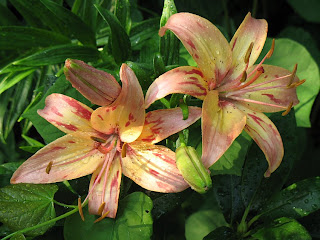For once I am on time for Bloom Day. Actually I'm ahead of time because I'm writing this on Thursday.
We are in a lull. The more interesting flowers have either bloomed or are getting ready to bloom. There are a few exceptions but most are of the most common variety.

Verbascum 'Southern Charm' Mullein
We usually planted the giant Verbascum olympicum which bloomed the second year after planting then died after blooming. It had a whitish silvery look because of the white hairs on the leaves and a weird twisting habit of its 6' tall flower stalk which would unwind as the flowers progressively bloomed from bottom to top. I was never able to find V. olympicum very easily and the ones sold as V. olympicum turned out to be something else so we stopped buying the plants. Instead we settled on the small V. 'Southern Charm' which is a perennial. This is the second year this one is blooming. Not physically imposing but nice nonetheless.



We bought several Delphinium plants at the local nursery because they had some varieties with interesting dusky colors. The blue was very striking so we had to add that to the collection even though we had several blues already.

This is a plain old field poppy that probably came in a box of wildflowers we planted several years ago. Why it turned up in a bed several dozen feet where it was originally sown I have no clue but there are many of the same plants in the bed. I do like the brilliant red and contrasting light mustard color of the stamens.

I was surprised to see this Dianthus which bloomed much later than the ones I blogged about earlier probably because it is under heavy shade. It must once have been planted in full sun but everything around it grew so it is almost completely shaded now. It is leggy but still blooms. It must be a very old plant because I don't remember planting Dianthus where it is growing.

I know, I know, it's just a plain old petunia. I had to give it some notice because I like the very nice brilliant dark pink-red color.

The first misshapen bloom of a day lily.


And two very plain asiatic lilies. The nicer ones are yet to bloom.


Finally, not to give short shrift to shrubs, here's a Viburnum that's blooming now. This is one of the first Viburnums we planted but I don't know what kind it is (V. lentago, V. Wrightii?). It has remained a medium sized shrub and is not as fast growing as some others. It also doesn't throw up suckers so it remains a neat bush.

























































